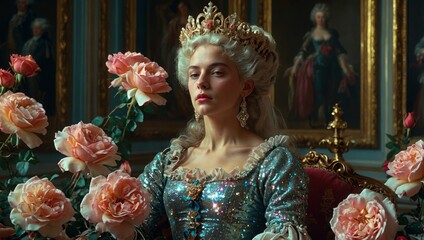The costumes in the film “Marie Antoinette,” directed by Sofia Coppola, are an unforgettable element that brings the story of France’s last queen to life. With their striking colors, intricate designs, and luxurious fabrics, these costumes not only serve as a feast for the eyes but also provide deep insights into Marie Antoinette’s character and the historical period in which she lived. This article will explore the significance of the costumes in the “Marie Antoinette” movie, highlighting their design inspiration, historical context, and impact on fashion and culture.
The Historical Context of Marie Antoinette
Marie Antoinette, born an Austrian archduchess, became the queen of France in the 18th century. Her reign was marked by political strife and social upheaval, leading to her eventual downfall during the French Revolution. The film captures her tumultuous life at the opulent court of Versailles, where extravagance and excess ruled the day. The costumes in the movie reflect the dual nature of her existence—both as a powerful queen and a victim of her circumstances.
The costumes play a crucial role in illustrating the societal expectations of the time and Marie Antoinette’s struggle to navigate her identity within the confines of royalty. Through an artistic lens, the film presents the lavish lifestyle of the French court while hinting at the underlying tensions that would ultimately lead to its demise.
Design Inspiration Behind the Costumes
Milena Canonero, the talented costume designer behind the “Marie Antoinette” movie, approached the task with a keen eye for detail and a deep understanding of historical fashion. Her work draws heavily from the styles and aesthetics of the 18th century, carefully recreating garments that reflect the grandeur of the period. Canonero’s designs are rooted in historical accuracy but are infused with a modern twist, making them accessible and appealing to contemporary audiences.
The vibrant color palette used in the costumes is one of the most striking aspects of the film. Soft pastels dominate Marie Antoinette’s wardrobe, symbolizing her youth and femininity, while deeper shades represent the gravitas of her role as queen. Each costume is crafted to convey emotions and character development, allowing viewers to connect with Marie Antoinette on a personal level.
Key Costume Elements in the Film
Fabrics and Textures
The use of sumptuous fabrics in the “costumes marie antoinette movie” elevates the visual storytelling to new heights. The gowns feature exquisite silks, brocades, and velvets that evoke the luxurious lifestyle of the French court. Each fabric choice not only enhances the aesthetic appeal but also serves to reflect the status and wealth of the characters.
In addition to the main garments, the film showcases a plethora of accessories, including lace, ribbons, and intricate embroidery. These embellishments add depth and dimension to the costumes, making them truly stand out. The meticulous attention to detail is evident in every scene, capturing the essence of 18th-century fashion.
Silhouettes and Styles
The silhouette of the costumes is another vital component that contributes to their impact. The film features various styles, from the extravagant wide skirts of the early 18th century to the more streamlined silhouettes that became popular later in the century. The evolution of these silhouettes mirrors Marie Antoinette’s journey, showcasing her transformation from a carefree young girl to a queen burdened by her responsibilities.
One of the most iconic costumes from the movie is the dramatic pink gown adorned with a large bow at the back, symbolizing both Marie Antoinette’s playful spirit and her indulgent lifestyle. Additionally, the elaborate masquerade ball attire, complete with ornate masks and rich fabrics, serves to highlight the excesses of the French court and the escapism sought by its members.
Iconic Costumes
Several costumes in the “Marie Antoinette” movie have left a lasting impression on viewers. The stunning blue gown worn during the masquerade is perhaps one of the most memorable, showcasing the queen’s flair for fashion and her desire to captivate those around her. Each outfit worn by Marie Antoinette is carefully chosen to reflect her personality and the themes of the film, from her youthful exuberance to her eventual isolation.
These iconic costumes not only define Marie Antoinette’s character but also serve as cultural touchstones, influencing modern fashion and inspiring designers worldwide. The film’s visual language creates a lasting legacy that continues to resonate with audiences today.
Cultural Significance of the Costumes
The costumes in the “costumes marie antoinette movie” offer more than just a glimpse into 18th-century fashion; they serve as a commentary on the social dynamics of the time. By showcasing the excesses and opulence of the French court, the film critiques the disconnection between the monarchy and the common people. The lavish costumes act as symbols of privilege and excess, prompting viewers to reflect on the consequences of such indulgence.
In a broader cultural context, the film has sparked renewed interest in historical fashion and has influenced contemporary design. The blending of past and present in Canonero’s costumes demonstrates how historical aesthetics can inform modern sensibilities, inspiring designers to incorporate elements of historical dress into their collections.
Behind the Scenes: The Costume Design Process
Creating the costumes for “Marie Antoinette” was a complex and time-consuming endeavor that required extensive research and collaboration. Milena Canonero worked closely with director Sofia Coppola to ensure that the costumes aligned with the film’s overall vision. The team conducted thorough research into 18th-century fashion, studying historical garments, paintings, and other primary sources to accurately portray the era.
Once the research phase was complete, Canonero began sketching designs and sourcing materials. The team sourced fabrics from various suppliers, often opting for historical textiles whenever possible. Each costume was crafted by skilled artisans, who dedicated countless hours to hand-sewing intricate details, ensuring that every aspect of the costume was authentic and true to the period.
This commitment to authenticity and craftsmanship is reflected in the film’s visuals, which create an immersive experience for viewers, allowing them to feel transported to the opulent world of Versailles.
Conclusion
The “costumes marie antoinette movie” are a breathtaking display of fashion that captures the essence of an era marked by extravagance and turmoil. Through the meticulous design and attention to detail, the film’s costumes not only serve as visual masterpieces but also as essential elements of storytelling. They convey the complexities of Marie Antoinette’s character and her struggle to find her place in a world filled with expectation and constraint.
As audiences continue to explore the legacy of Marie Antoinette, her costumes remain a powerful symbol of both beauty and tragedy, influencing fashion and cultural discussions for generations to come.
FAQs
What inspired the costumes in the Marie Antoinette movie?
The costumes were inspired by historical garments and fashion trends from the 18th century, combined with a contemporary twist to appeal to modern audiences.
Who was the costume designer for the Marie Antoinette film?
Milena Canonero was the costume designer, known for her innovative and historically informed designs that brought the characters to life.
How do the costumes reflect Marie Antoinette’s character?
The costumes evolve throughout the film, mirroring her personal growth and struggles, while also representing her status and the expectations placed upon her.
What impact did the costumes have on modern fashion?
The film’s costumes have influenced contemporary designers and sparked renewed interest in historical fashion, inspiring collections that incorporate 18th-century elements.
Are the costumes historically accurate?
While the costumes strive for historical accuracy, they also blend modern aesthetics, making them accessible and visually appealing to today’s audiences.







